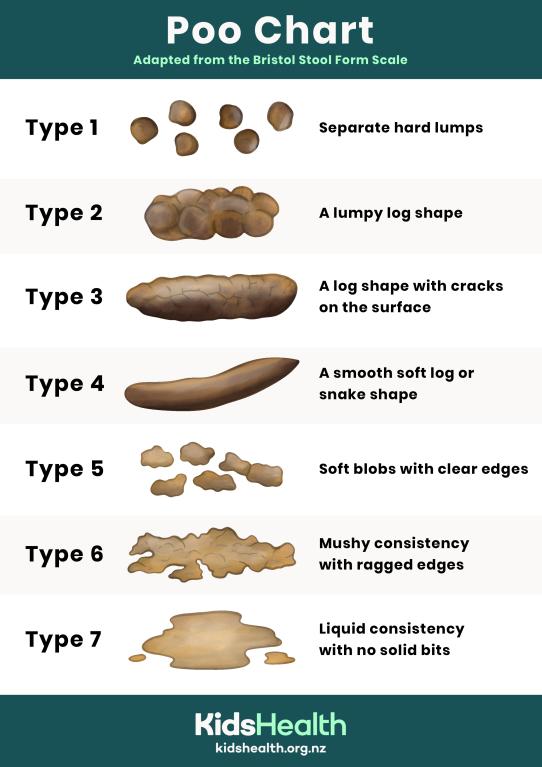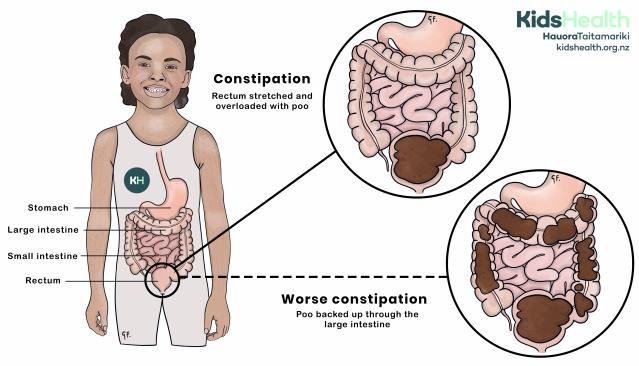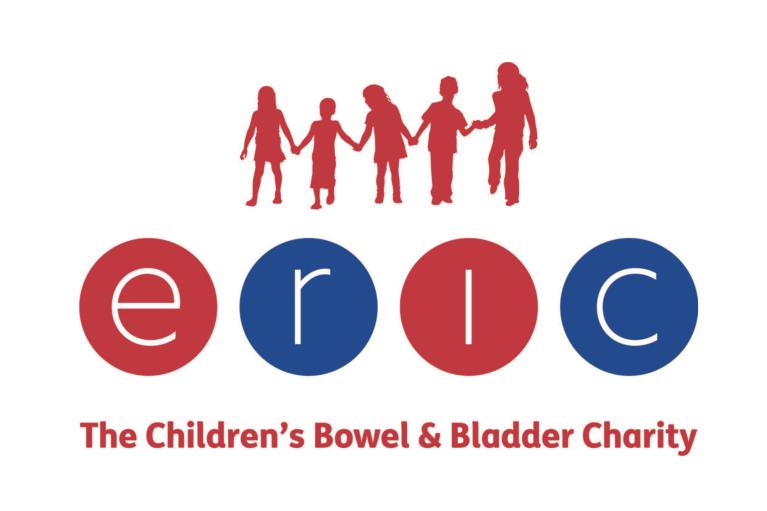Constipation animation
An animation about constipation, including symptoms and when you might need to see a health professional.
Source: KidsHealth
transcribeTranscript
Everyone poos differently, especially pēpi and tamariki.
If your child has firm, hard or painful poo, they are likely to be constipated.
This can cause tummy pain.
Constipation is common in tamariki.
There are many possible reasons why tamariki get constipated.
Constipation can often get worse for tamariki the longer it goes on.
If your child is constipated, there are a few things that may help.
Encourage your child to sit on the toilet for several minutes in the morning. Even if they don't do a poo, still encourage this.
Star charts can help everyone remember to do this.
Make sure your child is comfortable sitting on the toilet.
It may help to use a child's toilet seat for preschoolers.
For younger tamariki, put a stool under their feet so their knees are higher than their hips.
Encourage your child to lean forward and rest their elbows on their knees.
Make sure your child is drinking water regularly.
Encourage them to eat lots of fruit and veges.
You could try giving your child prunes or KiwiCrush (a kiwi fruit drink) daily.
Encourage regular activity.
Call Healthline on 0800 611 116 or see a health professional if:
- your child has tummy pain
- or the constipation is getting worse
- or your child finds toileting very upsetting
- or your child is having poo accidents
Your health professional may give your child medicine to help their constipation.
These are called laxatives. Follow your health professional’s instructions.
You may need to see your health professional again if the constipation doesn’t get better.
Most tamariki with constipation get better with things you can do at home.
An animation about constipation, including symptoms and when you might need to see a health professional (in te reo Māori).
Source: KidsHealth
transcribeTranscript
He rerekē te tikotiko a tēnā, ā tēnā, ina koa rā ngā pēpi me ngā tamariki.
Mēnā he mārō, he uaua, he mamae te tiko a tō tamaiti, tērā pea kua kōreke.
Ka ngau pea te puku i te mate nei.
He pātahi noa te mate kōreke i ngā tamariki.
He huhua pea ngā take i kōreke ai ngā tamariki.
Ka kino haere pea ki te roa rawa te wā e pāngia ana e te mate kōreke.
Mēnā kua tina te kōpū o tō tamaiti, tērā ētahi mea hei āwhina ake.
Me akiaki i tō tamaiti kia noho ki te wharepaku mō tētahi wā i ngā ata. Ahakoa e kore pea e tiko, me akiaki tonu.
He āwhina pea ngā tūtohi whetū, e mahara ai koe ki tēnei mahi.
Me whakarite mēnā kei te hāneanea te noho a tō tamaiti ki te wharepaku.
Me whakamahi pea he tūru tamariki mā ngā kōhungahunga.
Mō ngā tamariki nohinohi, me waiho he paekake ki raro i ngā waewae, kia teitei ake ngā pona i ō rātou hope.
Me akiaki i tō tamaiti kia wharara whakamua, kia tau ai ngā pona ringa ki ngā pona waewae.
Me rite tonu te inu wai a tō tamaiti.
Me akiaki i a ia kia kai i ngā hua whenua me ngā hua rākau.
Me whāngai pea ki te purūne, ki te KiwiCrush (he inu hua kiwi) rānei i ia rā.
Me akiaki i a ia kia kori i ia rā.
Me waea ki Healthline 0800 611 116 me tiro rānei i tētahi mātanga hauora mēnā:
- kei te ngau te puku o tō tamaiti
- kei te kino haere rānei te mate kōreke
- he pairi rānei ki tō tamaiti te noho ki te wharepaku
- kei te mate tikotiko rānei tō tamaiti
Ka tukua pea e tō mātanga hauora he rongoā hei āwhina i te mate kōreke.
Ka kīia ēnei he rongoā whakatiko. Whāia ngā tohutohu a tō mātanga hauora.
Me toro anō pea koe ki tō mātanga hauora ki te kore e pai mai te mate kōreke.
Ka ora mai ai ngā tamariki mate kōreke ki te whakatikatika koe i ngā tikanga i te kāinga.
An animation about constipation, including symptoms and when you might need to see a health professional (in Samoan).
Source: KidsHealth
transcribeTranscript
E eseese foliga o feaumamao i tagata uma, aemaise pepe ma tamaiti.
A malō feaumamao, oono po o le tiga, o lona uiga ua mamau le manava o si au tama.
E tiga ai le manava.
E masani ai le mamau o manava o tamaiti.
E tele faapogai e mamau ai manava o tamaiti.
E faateteleina le mamau o manava i tamaiti pe a umi tele o faapena ai lava.
E iai mea e fesoasoani i si au tama, pe a mamau lona manava.
A oo i le taeao, faatietie i le ipu faleuila. Tusa lava pe le o tatala le manava, faasaofai pea.
E manaia faafetu e manatua ai e tagata uma.
Vaai po o tietie lelei.
Atonu e fetaui ituaiga ipu maualalo o faaaoga i aoga amata.
Avane se mea e tuu ai luga vae o fanau laiti, ia luga teisi tuli mai puimanava.
Fai i ai e punou teisi ma lago tulilima i tuli.
Mautinoa o toaga e inu vaiauli.
Faamalosi i ai e ‘ai fualaauaina ma fualaau faisua.
Faataitai na fafaga i vine mago po o le faainu i le KiwiCrush.
Taumafai e faagaioi.
Valaau le Healthline i le 0800 611 116 po o le vaai se tomai faalesoifua maloloina pe afai:
- ua tiga lona manava
- po o le faateteleina le mamau o lona manava
- po o le ita pe a faatietie i le ipu faleuila
- po o le faitataga ona ua lē mafai na tatali
Atonu e avatu e le tomai faalesoifua maloloina fualaau e tatala ai le manava.
O fualaau e ta‘u o laxatives. Mulimulitai i faatonuga e faainu ai.
Atonu e moomia na toe ave e vaai le tomai faalesoifua maloloina pe a leai se suiga.
O le toatele o tamaiti e mafai na togafitia tulaga faapenei i le fale.
An animation about constipation, including symptoms and when you might need to see a health professional (in Tongan).
Source: KidsHealth
transcribeTranscript
‘Oku kehekehe pē ‘a e tu‘umama‘o ‘a e tokotaha kotoa pē, tautautefito ki he fanga ki‘i pēpeé mo e fānaú.
Kapau ‘oku fefeka pe mamahi ‘a e tu‘umama‘o ‘a ho‘o tamá, ‘oku ngalingali leva ke palopalema‘ia ‘enau tu‘umama‘ó (constipated).
‘E lava ke fakatupunga ai heni ha langa kete.
‘Oku angamaheni ‘a e hoko ‘a e faingata‘a ‘o e tu‘umama‘ó ‘i he fānaú.
‘Oku lahi ‘a e ngaahi ‘uhinga ‘e ala faingata‘a ai ‘a e tu‘umama‘o ‘a e fānaú.
‘E ala faka‘au ke kovi ange ‘a e faingata‘a ‘a e tu‘umama‘o ‘i he fānaú ‘i he lōloa ange ‘ene hokó.
Kapau ‘oku faingata‘a ‘a e tu‘umama‘o ‘a ho‘o tamá, ‘oku ‘i ai ha ngaahi me‘a ‘e ni‘ihi ‘e ala tokoni.
Faka‘ai‘ai ho‘o tamá ke ta‘utu ‘i he toiletí ‘i ha ngaahi miniti lahi ‘i he pongipongí. ‘O tatau ai pē kapau ‘oku ‘ikai ke nau tu‘umama‘o mai, kei faka‘ai‘ai pē eni.
‘E lava ke tokoni ‘a e star charts ki he tokotaha kotoa pē ke nau manatu‘i ‘o fai eni.
Fakapapau‘i ‘oku fiemālie ‘a e ta‘utu ‘a ho‘o tamá ‘i he toiletí.
‘E lava ke tokoni hono ngāue‘aki ‘a e sea toileti ma‘á e fānaú ki he fānau te‘eki ai akó.
Ki he fānau iiki angé, tuku ha ki‘i tu‘u‘anga (stool) ‘i honau lalo va‘é ke fakamā‘olunga‘i ‘aki honau ongo tuí ‘i ‘olunga honau konga lotó.
Faka‘ai‘ai ho‘o tamá ke ki‘i mapelu ki mu‘a pea mālōlō leva honau ongo tui‘inimá ‘i honau ongo tuí.
Fakapapau‘i ‘oku hokohoko ‘a e inu vai ‘a ho‘o tamá.
Faka‘ai‘ai kinautolu ke nau kai ke lahi ‘a e fua‘i‘akaú mo e vesitapoló.
Te ke ala ‘ahi‘ahi ‘oange ki ho‘o tamá ha ngaahi fo‘i prunes pe KiwiCrush (ko ha inu ngaohi mei he kiwi fruit) ‘i he ‘aho kotoa pē.
Faka‘ai‘ai ke nau fai ha ngaahi me‘a (activity) ‘o hokohoko.
Telefoni ki he Healthline ‘i he fika 0800 611 116 pe sio ki ha tokotaha ngāue fakapalofesinale ki he mo‘ui leleí kapau:
- ‘oku langa kete ‘a ho‘o tamá
- pe faka‘au ke kovi ange ‘a e faingata‘a ‘o ‘ene tu‘umama‘ó
- pe ‘oku faingata‘a‘ia ‘aupito ‘i he ‘ene ‘alu ki he toiletí
- pe ‘oku fetō‘aki ‘ene tu‘umama‘ó (poo accidents)
‘E lava ke ‘oatu ‘e ho‘o tokotaha ngāue fakapalofesinale ki he mo‘ui leleí ha faito‘o ki ho‘o tamá ke tokoni ki he faingata‘a ‘o ‘enau tu‘umama‘ó.
‘Oku ui eni ko e laxatives. Muimui ki he ngaahi fakahinohino ‘a ho‘o tokotaha ngāue fakapalofesinale ki he mo‘ui leleí.
‘E ala fiema‘u ke ke toe sio ki ho‘o tokotaha ngāue fakapalofesinale ki he mo‘ui leleí kapau ‘oku ‘ikai faka‘au ke sai ‘a e faingata‘a ‘a e tu‘umama‘ó.
Ko e tokolahi taha ‘o e fānau ‘oku faingata‘a ‘enau tu‘umama‘ó te nau sai pē kinautolu ‘i he ngaahi me‘a te ke ala fai pē ‘i ‘apí.
Watch an animation on constipation in your preferred language.
Key points about constipation
- constipation is when your child has firm, hard or painful poo
- it's a common cause of tummy pain in tamariki (children)
- constipation can often get worse the longer it goes on
- drinking water, eating lots of fruit and veges and regular activity all help
- regularly sitting on the toilet in the morning is also helpful
- some tamariki need laxatives for several months to help their constipation
- most tamariki with constipation get better with things you can do at home
Normal poo
Everyone poos differently, especially pēpi (babies) and tamariki.
Breastfed babies
Some healthy breastfed pēpi poo several times a day and others may only poo once every 10 days. The poo of breastfed pēpi is mustard yellow, soft and can look like it has seeds in it.
Formula-fed babies and older children
Most formula-fed pēpi and older tamariki poo every day or every second day. Poo should mostly be like a soft log, like type 4 in the diagram below.
Poo chart - different types of poo

Chart showing 7 different types of poo. Adapted from the Bristol stool chart.
Source: KidsHealth
transcribeTranscript
An illustrated chart showing 7 types of poo. Each type is based on shape and texture.
Type 1: separate hard lumps.
Type 2: a lumpy log shape.
Type 3: a log shape with cracks.
Type 4: smooth soft log or snake shape.
Type 5: soft blobs with clear edges.
Type 6: mushy with ragged edges.
Type 7: liquid with no solid bits.
The chart is from KidsHealth New Zealand. At the bottom of the chart is the KidsHealth logo with the website: kidshealth.org.nz.
You can download and share or print a copy of the KidsHealth poo chart below.

Source: KidsHealth
What is constipation?
If your child of any age has firm, hard or painful poo, they are likely to have constipation.
Some tamariki who poo less than every 3 days may also have constipation.

Illustration of a child showing the difference between constipation and worsening constipation.
Source: KidsHealth
transcribeTranscript
This is an illustration of a child showing their digestive system. The organs are labelled as:
- Stomach
- Large intestine
- Small intestine
- Rectum
There are 2 close-up pictures:
- Constipation: The rectum is stretched and overloaded with poo.
- Worse constipation: Poo is backed up through the large intestine.
At the top right is the KidsHealth logo with the website: kidshealth.org.nz.
Signs and symptoms of constipation
Signs of constipation in tamariki include:
- small hard lumps of poo (like type 1 on the poo chart)
- firm, hard poo (like type 2 on the poo chart)
- poo that is large and hard to pass
- not pooing for 3 or more days
- pain or crying when pooing
- bright red blood on the toilet paper after wiping
- tummy pain that comes and goes
- poo stains ('skid marks') in underwear
- liquid poo (soiling) that leaks out in between harder poo
- poo accidents
- feeling sick or not eating as much
Tamariki with constipation are also more likely to:
- have urinary tract infections (UTIs)
- wet themselves
- wet the bed
Causes of constipation
There are many causes of constipation. Sometimes it is more than one thing.
Causes include:
- not eating enough fruit and veges
- not drinking enough water
- not being active
- weaning from breastmilk to formula or starting solids
- having a naturally slower moving gut
Toileting habits are important. Tamariki can get constipation if they:
- don't sit on the toilet regularly
- ignore the urge to do a poo
- don't let all the poo come out when going to the toilet
- avoid pooing because it's painful or scary
The painful constipation cycle
When your child feels the urge to poo, they may hold on to the poo to avoid pain. This makes the poo harder, larger and even more painful to pass. Your child can become even more scared to poo. This creates a cycle of worsening constipation.

Illustration of the constipation cycle.
Source: KidsHealth
transcribeTranscript
This illustration shows the common cycle that can occur with constipation.
The cycle has 3 stages connected by curved arrows:
- Pain - The starting point at the top
- Hard Poo - On the right side
- Trying to avoid pain by 'holding on' to poo - On the left side
The arrows show how this creates a cycle.
The key to stopping this cycle is making the poo soft and easier to pass.
Find out what you can do to make your child's poo softer and easier to pass.
Constipation Treatment For Children
When constipation continues for a long time
Constipation that continues for a long time can cause an overloaded and stretched bowel. Tamariki may then lose the urge to poo. This can lead to soiling accidents.
When to get medical help for constipation
Call Healthline on 0800 611 116 or see a health professional if:
- your child has tummy pain
- the constipation is getting worse
- your child finds toileting very upsetting
- your child is having poo accidents
You may need to see your health professional again if the constipation doesn’t get better.
More information

Continence NZ has videos, resources, and links which can be helpful and informative for parents, whānau, or anyone else supporting children with constipation.

ERIC provides information for parents, children, adolescents and health professionals on continence issues. The website has a number of leaflets to download.
Acknowledgements
Illustrations and stool chart adaptation by Dr Greta File. Property of KidsHealth.
